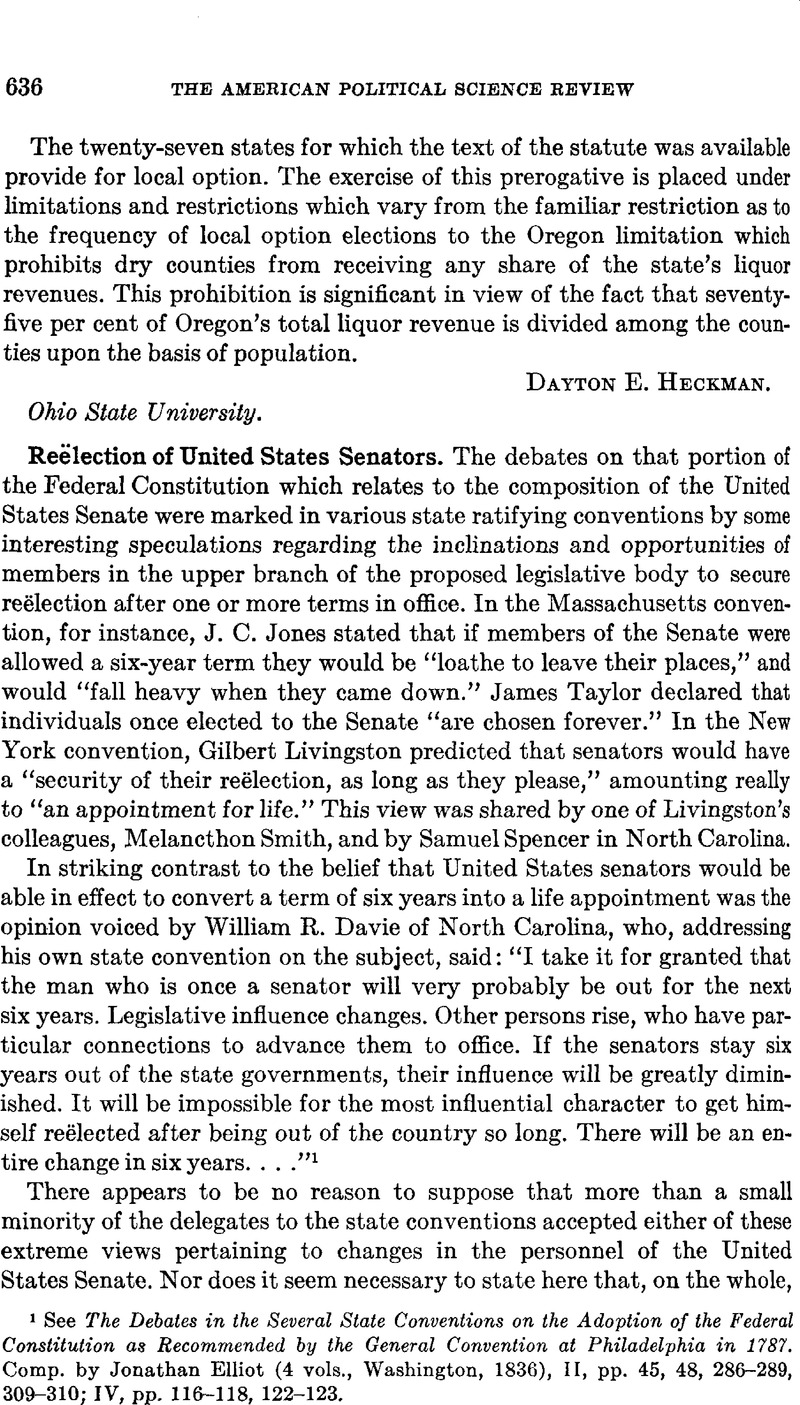No CrossRef data available.
Article contents
Reëlection of United States Senators
Published online by Cambridge University Press: 02 September 2013
Abstract

- Type
- Legislative Notes and Reviews
- Information
- Copyright
- Copyright © American Political Science Association 1934
References
1 See The Debates in the Several State Conventions on the Adoption of the Federal Constitution as Recommended by the General Convention at Philadelphia in 1787. Comp. by Elliot, Jonathan (4 vols., Washington, 1836), II, pp. 45, 48, 286–289, 309–310Google Scholar; IV, pp. 116–118, 122–123.
2 The names of the senators are given, of course, in the various directories for successive sessions of Congress. A convenient collection of the necessary data, summarized and arranged by number for each Congress through the Sixty-ninth, is printed as The Biographical Directory of the American Congress, 1774–1927 (Washington, 1928)Google Scholar, issued as 69th Cong., 2nd Sess., House Doc. 783. Unless otherwise designated, all further statements and figures here given are based on one or more of these sources.
It should be explained further that for the purpose in hand a single membership in the Senate is considered only in terms of consecutive periods of service. A reëlected member, therefore, is one who has been elected one or more times immediately to succeed himself.
The study is meant to be wholly objective. Deaths while in office and resignations or withdrawals from office do not alter the standings of the members concerned at their last previous elections. Purely ad interim appointments are not considered. A member chosen in a special election to fill an unexpired term is regarded neither as an old nor as a new member during such an incumbency. If reëlected, moreover, he is considered as holding then only a second term regardless of what may have been the status of the member whom he succeeded. The first members to hold seats in the Senate from newly admitted states, and those from the South following reconstruction after the War between the States, do not figure in the reckoning until at the end of their respective terms. These various irregularities, therefore, do not lower the general average of reëlected members, although they do tend to decrease the percentages of the number serving three or more successive terms.
3 This, incidentally, is true for any six years that may be selected. It is to be understood, however, that unless specified otherwise all references to six-year periods in this discussion denote some one of a group of three Congresses, counted in regular and consecutive order, beginning with the Second; as, for example, the Second, the Third, and the Fourth, from 1791 to 1797, the Fifth, the Sixth, and the Seventh, from 1797 to 1803, etc.
4 American Government and Politics (5th ed., New York, 1930), pp. 239–240Google Scholar.
5 Haynes, G. H., The Election of Senators (New York, 1906), p. 226Google Scholar. Professor Haynes accepted the view that the almost inevitable result of popular election, judged in the light of the history of elective offices, would be a shortening of senatorial careers. Ibid., p. 268.
6 The percentages of reëlections in 1910, 1912, and 1914 (considering, of course, only those members whose terms expired the following year in each case) were 43.33, 40.62, and 71.87, respectively.
7 The basis for the selection of these states was, naturally, the population per square mile as given in the United States census reports. The 15 sparsely settled states in 1880 were: Nevada, Oregon, Colorado, Florida, Nebraska, California, Texas, Minnesota, Kansas, Arkansas, Louisiana, Maine, Wisconsin, Mississippi, and West Virginia. As a result of the admission of new states, and shifts in population as well, the composition of this group changed often. At the beginning of the Fifty-third Congress in 1891, for instance, Arkansas, Louisiana, Wisconsin, Mississippi, Maine, and West Virginia were supplanted by six new states: Wyoming, Montana, Idaho, North Dakota, South Dakota, and Washington. According to the 1930 census, the group consisted of Nevada, Wyoming, New Mexico, Montana, Arizona, Idaho, Utah, Oregon, Colorado, South Dakota, North Dakota, Nebraska, Texas, Kansas, and Washington. In 1880, the densely populated states were: Rhode Island, Massachusetts, New Jersey, Connecticut, New York, Pennsvlvania, Maryland, Ohio, Illinois, Delaware, Indiana, Kentucky, Tennessee, New Hampshire, and Virginia. Throughout, this list remained rather constant. Only three changes may be noted for the whole period: New Hampshire, Tennessee, and Virginia were replaced by West Virginia, Michigan, and North Carolina, respectively. It should be explained that the shifts made within these two groups of states affected but very slightly at the most the existing trends of percentages for re-elections.





Comments
No Comments have been published for this article.